This homemade beef broth recipe is frugal, deeply flavorful, and nutrient-dense. Here’s how to make it easily in the Instant Pot, Crock Pot, or on the stove!
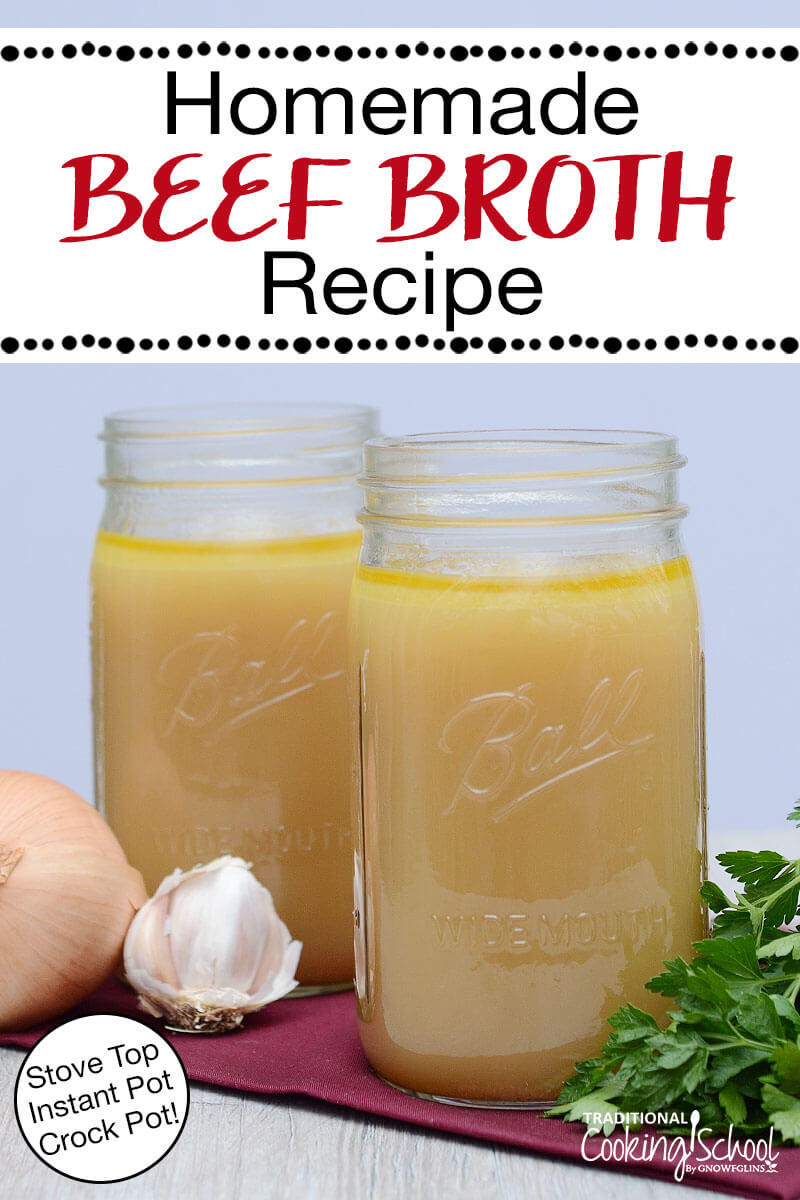
Do you make healing bone broth at home?
If not, you are missing out on a deeply flavorful, nutrient-dense food that is far superior than anything you can by at the supermarket!
Beef broth is an important part of a traditional food kitchen. It is full of minerals, collagen, amino acids, and healthy fats. It adds amazing flavor to soups and stews, is a nutrient-dense food, and is extremely healing to the gut.
Broth is not only nutritious, it is also incredibly frugal; a great way to use leftover bones and scraps of vegetables that may otherwise be discarded. You can even try making perpetual broth to always have broth ready.
Making it yourself will save a lot of money when compared to buying at the store. You’ll save even more if you compare it to purchasing high end, traditionally prepared broth, which can be very expensive.
What is driving the fad of drinking ‘bone broth’?
Broth is not confined to soup these days. Many drink it daily as a beverage in order to promote wellness (even consuming it for breakfast!).
It may seem that drinking broth is a fad; even trendy cafes offer it in a to-go cup.
There’s also the beef broth diet, which has grown in popularity. This diet claims to “improve blood sugar, skin wrinkles, gut health, inflammation, and joint pain” (Source).
Research is unclear as to how and why drinking bone broth has become so popular. In my personal opinion, the rise in awareness of gut health may have something to do with it.
The other reason may be the “beautifying” aspect of consuming broth. Many suggest the collagen in broth helps grown and fortify hair, skin, and nails.
The truth is, beef broth is extremely healthy (it’s not a myth!) and drinking it as a beverage or including in soups is an excellent idea.
While it may seem like this trend is new, making and consuming broth has been part of traditional diets for thousands of years.
Beef Broth Vs. Stock
Many wonder, what is the difference between stock and broth? Great question!
At first glance, they seem like the same thing. And for many of us, the difference isn’t a big deal.
Broth is technically the liquid in which meat is cooked. It does not necessarily include bones, but often does. It may include some vegetables and is usually seasoned.
Beef stock often has a richer flavor and always includes bones. It is cooked for a longer amount of time than broth to allow the nutrients and flavor of the bones to be released.
Bone broth is cooked for even longer than regular broth or stock. This broth includes bones and connective tissues of animals and is often seasoned.
If you are familiar with the GAPS Diet, you may have heard the terms “meat stock” and “bone stock.” Meat stock is used at the beginning of the GAPS diet and only cooked for a few hours. This stock is thought to help the gut-healing process.
“Bone stock” is used in the later stages of the GAPS diet, once healing has begun. It is cooked for much longer than meat stock (48 to 72 hours).
For more info, read What’s The Difference Between Stock & Broth?
Learn more about the GAPS Diet here!
Homemade Beef Broth Recipe
Many complain that homemade beef broth is not very tasty. If you agree, I hope the tips below will help.
Tasteless-broth can be due to a variety of reasons, such as the choice of bones or length of time cooked. Skipping the roasting step will also result in less flavor.
To make the very best, most nutritious, and flavorful beef broth, implement these important steps:
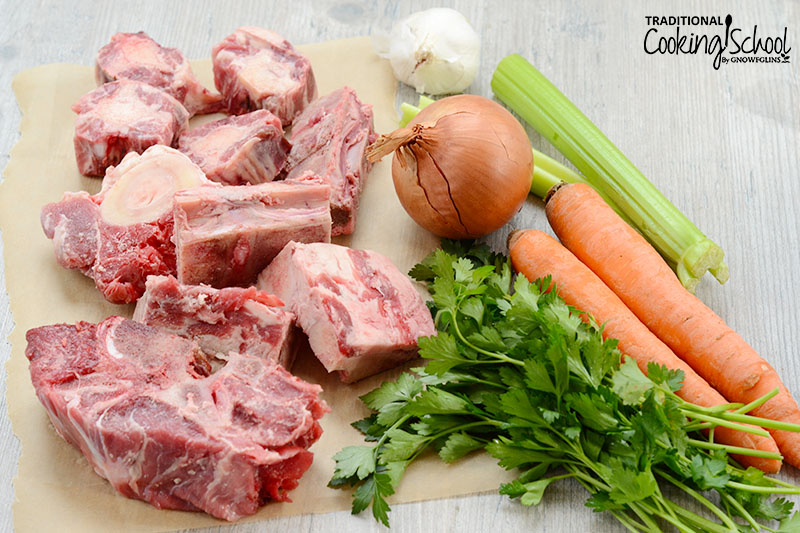
#1 — Choose High Quality Soup Bones
One of the most important ingredients in any beef broth recipe is the bones. Often called soup bones, or stock bones, these bones are leftover after butchering.
Unlike marrow bones, soup bones usually have some meat left on them.
Marrow bones are a good (and important) addition to beef broth, however, I don’t recommend they be the only bone used, as the resulting broth won’t be as flavorful. That said, marrow bones are full of nutrients and should definitely be included.
In fact…
“A University of Michigan-led study shows that the fat tissue in bone marrow is a significant source of the hormone adiponectin, which helps maintain insulin sensitivity, break down fat, and has been linked to decreased risk of cardiovascular disease, diabetes, and obesity-associated cancers.” (Source)
If you want to learn more about marrow bones, check out The Best Ways To Extract Marrow For Bone Broth.
When selecting bones for broth, use grass-fed and grass-finished whenever possible. This ensures the highest quality.
Finally, it’s best to use a variety of bones, including knuckles, joints, marrow bones, oxtail, shank, short ribs, and feet. Be sure to include meaty bones for the best flavor.
Where do I get beef bones for making broth and stock?
Your local butcher will often have soup bones available as will some health food stores and farmer’s markets. If you purchase a side of beef, be sure to request the leftover bones.
Keep a container in the freezer to save bones from roasts and steaks. These make great broth too!
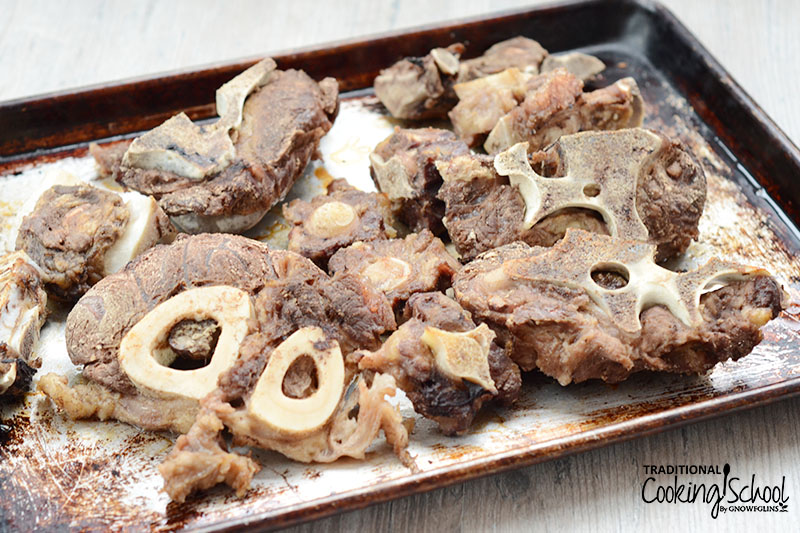
#2 — Roast Meaty Bones
To add great depth of flavor that can’t be achieved any other way, roast meaty soup bones!
Bones that are leftover from previous meals and have already been cooked do not need to be roasted.
It is also not necessary to roast bones that have no meat.
Here’s how to roast bones:
- Preheat oven to 400 degrees Fahrenheit.
- Place bones on a baking sheet or roasting pan.
- Roast for 20 minutes.
- Flip bones with tongs.
- Roast for another 20 minutes or until bones begin to brown.
Once roasted, place bones in a stock pot along with any brown bits that remain in the pan (these are extra flavorful!).
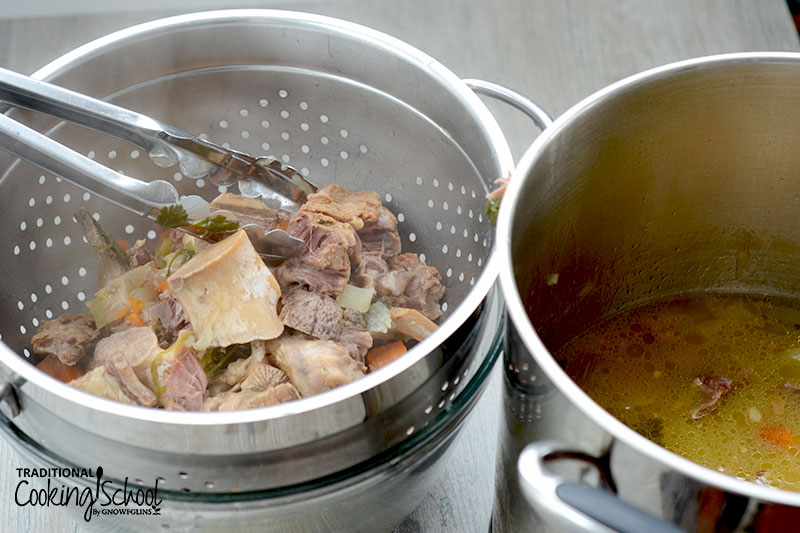
#3 — Soak Bones With Raw Apple Cider Vinegar
Vinegar helps draw the minerals out of the bones, marrow, and cartilage.
For this step, place roasted and un-roasted bones in a large pot. Then add vinegar and cover with pure water.
In the recipe below, I used 1/2 cup raw apple cider vinegar along with 4 to 5 pounds of bones.
If you find the vinegar flavor is too strong, reduce the vinegar to 2 to 4 tablespoons. You can build up over time as you get used to the flavor.
Here’s how to make your own raw apple cider vinegar at home!
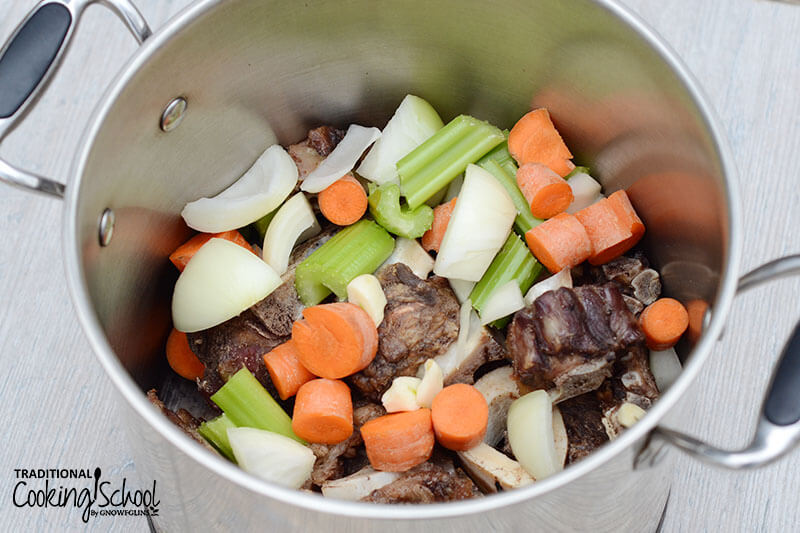
#4 — Simmer For 12 To 72 Hours
Cooking time varies, however.
The longer beef bones are simmered, the more flavor they offer. Because many soup bones are thick and hard, it takes some time for the nutrients and flavor to be released.
So, how long should you boil beef bones for bone broth?
To achieve the most nutritious result and richest flavor, your beef broth recipe should include a simmering step of 12 to 72 hours.
If you are concerned about leaving a pot on the stove for that long, feel free to make broth in a slow cooker or Crock Pot.
#5 — Keep Veggies To A Minimum
Vegetables can overpower and completely change the taste of your broth.
A few simple vegetables, such as garlic, onion, and celery will suffice. Carrots work well too, but only 1 to 2 are needed.
The roasting step adds so much flavor, it is not necessary to add many extra vegetables.
Of course, vegetables are wonderful and nutritious, but if you are making a large batch of broth or stock for multiple uses, it can be beneficial to keep the rich beef flavor predominant and allow it to be adjusted when used in meals. That way it remains suitable for a variety of dishes.
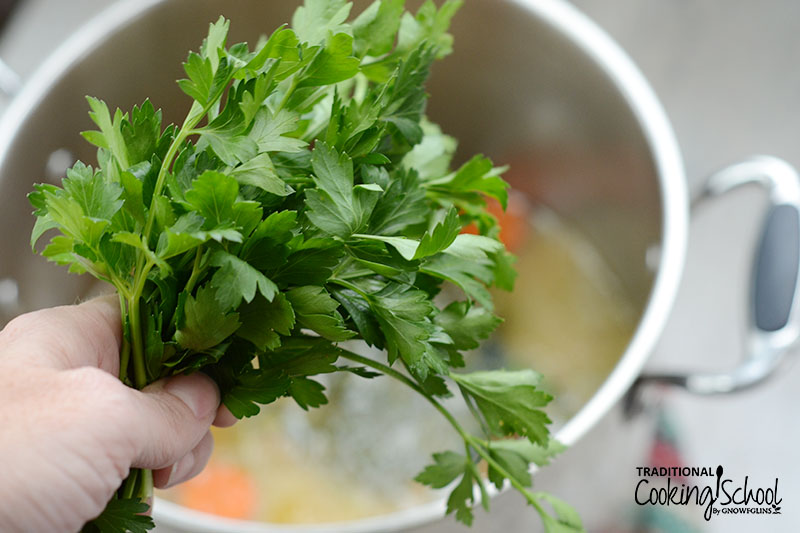
#6 — Add Herbs During The Last 30 Minutes Of Cooking
Herbs add a lot of extra flavor, which is a good thing! But, if they are added too soon, herbs will completely dominate the beef broth recipe.
It’s best to add herbs, such as parley, thyme, or rosemary, during the last 30 minutes of cooking. A handful of herbs is usually enough.
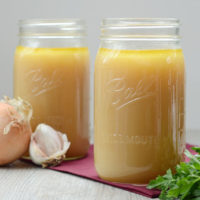
Beef Bone Broth Recipe
Homemade beef bone broth is frugal, deeply flavorful, and nutrient-dense. Here's how to make it easily in the Instant Pot, Crock Pot, or on the stove!
Ingredients
- 4 to 5 pounds beef bones meaty and non-meaty
- 1-1/4 to 1-1/2 gallons pure water approx. 20 to 24 cups of water
- 1 to 2 medium onions peeled and quartered
- 1 to 2 large carrots cut into 1 to 2 inch segments
- 1 rib celery cut into 1 inch slices
- 2 cloves garlic minced, optional
- 1/4 cup raw apple cider vinegar
- 1 to 2 bay leaves optional
- 6 to 10 whole black peppercorns optional
- 1 handful fresh parsley optional
Instructions
-
Preheat oven to 400 degrees Fahrenheit.
-
Place meaty bones on a baking sheet or roasting pan. Roast for 20 minutes.
-
Use tongs to turn bones over and roast for another 20 minutes or until bones begin to brown. Remove from oven.
-
Place roasted bones (and any browned bits or drippings), un-roasted bones, vegetables, vinegar, and purified water in a large pot.
-
Leave to soak for 60 minutes, if possible. This will allow the vinegar to work at drawing the minerals out of the bones.
-
Bring to a boil, then reduce heat to a simmer and cover.
-
Simmer for 12 to 72 hours. Skim away any scum that rises to the surface periodically.
-
Add herbs during the last 20 to 30 minutes of cooking.
-
Once cooking time has passed, let broth cool briefly, then remove large bones and vegetables with a slotted spoon or tongs and set aside. Once cool, remove any meat that's left on the bones and store for use in future meals.
-
Pour remaining broth through a fine mesh strainer or colander that is set over a bowl or large pot before transferring to jars. You can also pour directly into jars, just use a lot of care and caution when doing so. If the pot is too large, use a label or large measuring cup to scoop out the broth into the jars.
-
Pouring through a fine mesh strainer helps remove any extra bits and creates the smoothest broth.
Recipe Notes
To cook broth in your Crock Pot or slow cooker:
- Place roasted meat bones (and any browned bits or drippings) into the cooker.
- Add any extra unroasted bones, vegetables, and vinegar.
- Leave to soak for 1 hour.
- Cook on high for 1 hour then turn to low for another 12 to 72 hours.
- Skim away any scum that rises to the surface periodically.
- Add herbs during the last 20 to 30 minutes of cooking.
To cook broth in your Instant Pot or other pressure cooker:
- Roast bones as directed above, then place in the insert pot.
- Add remaining ingredients, and enough cold water to fill to an inch below the Max Fill line (be sure not to exceed this line).
- Cover the pot, checking the seal and components to make sure all is well.
- Cook on high pressure for 75 minutes.
- Once cooking time has passed, release pressure via quick or natural release.
- Strain and store broth as directed above.
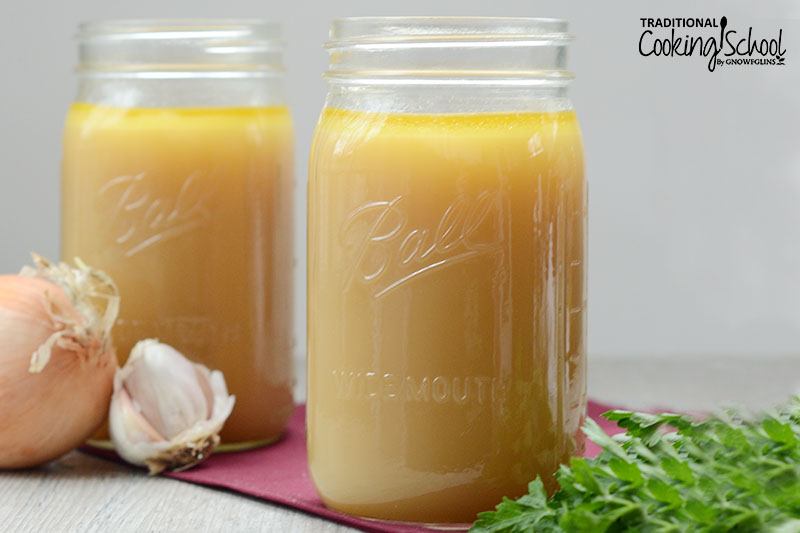
Beef Broth FAQs
Can bone broth be made quickly?
They only way to make beef broth quickly is to use an Instant Pot.
I find the crock pot is generally “fast” even though it takes a long time to cook. The reason being, it requires very little hands-on time.
The other way to make beef broth quickly is to be sure you add it to your monthly routine so there’s always some in the freezer.
All that said, to make broth quickly, the Instant Pot is your best bet. (Here’s how to use a pressure cooker or instant pot 101.)
Beef Bone Broth In The Instant Pot
Here’s how to make broth in your Instant Pot or other pressure cooker:
- Roast bones as directed above, then place in the insert pot.
- Add remaining ingredients, and enough cold water to fill to an inch below the Max Fill line (be sure not to exceed this line).
- Cover the pot, checking the seal and components to make sure all is well.
- Cook on high pressure for 75 minutes.
- Once cooking time has passed, release pressure via quick or natural release.
- Strain and store broth as directed above.
How should I store bone broth?
If you’ve ever started to prepare a meal, read the ingredients list and wondered, “Can I substitute water for broth?”
Well, first of all, you’re not alone. Second of all, the solution is easy!
Make a big batch of this beef broth recipe, and store it in the freezer so you’re never without. Your meals will be the most nutrient-dense and flavorful they can be!
Plus, you’ll avoid using store-bought versions, which are less nutritious and often contain additives (and even sugar).
Keep in a sealed container in the fridge for up to a week. Freeze for up to 6 months.
To freeze in jars, be sure to leave an inch of headspace. Thaw in the fridge.
To freeze in ice cube trays, thaw in a pot on the stove-top, in a slow cooker, or in the fridge.
Broth not tasting great?
If your broth doesn’t taste great after implementing all of the tips above, you could blanch the bones before roasting.
Blanching soup bones is often suggested as a means of removing impurities, which in turn results in a tastier broth.
Experiment with blanching and not blanching to see what you like best.
To blanch bones, place bones in a large pot and cover with filtered water, bring to a boil, and simmer for 15 to 20 minutes.
Drain and pat dry for roasting.
Check out our broth archives for even more gut-healing goodness!
- 8 Ways To Get That Broth In (without drinking it straight!)
- 5 Ways To Make Your Bone Broth More Exciting
- What To Do With Bitter Broth
- Homemade Vegetable Broth Recipe (Stove Top, Instant Pot)
- The Best Ways To Extract Marrow For Bone Broth #AskWardee 070
- What’s The Difference Between Stock And Broth? #AskWardee 151
Do you have a favorite beef broth recipe? How do you like to use up your broth?
...without giving up the foods you love or spending all day in the kitchen!

2 free books:
Eat God's Way
Ditch the Standard American Diet, get healthier & happier, and save money on groceries...
We only recommend products and services we wholeheartedly endorse. This post may contain special links through which we earn a small commission if you make a purchase (though your price is the same).


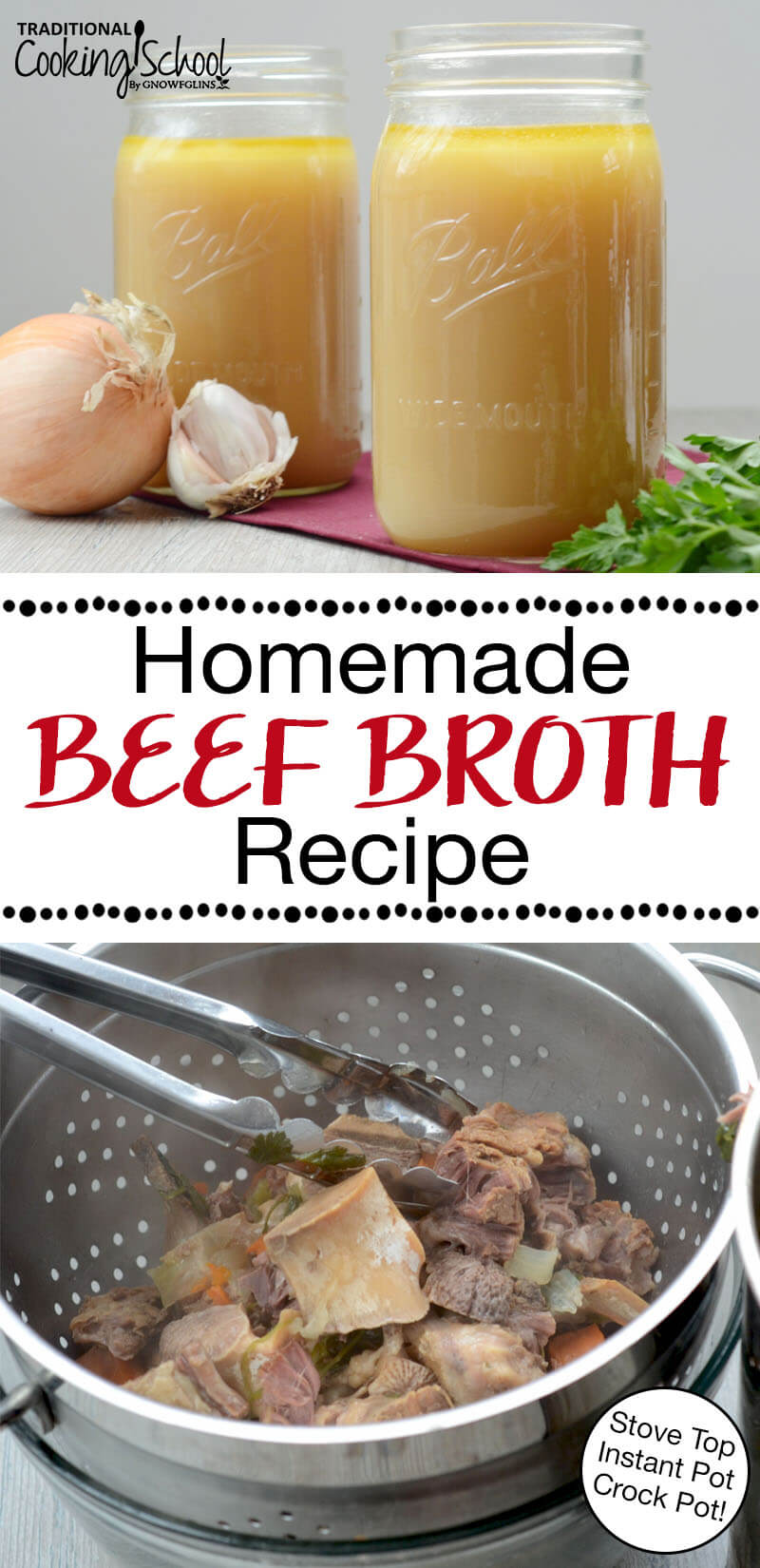
Can you pressure can the broth in jars to use later?
Yes, I pressure can my homemade bone broth all the time. A great tutorial is here: https://www.theprairiehomestead.com/2012/12/how-to-can-homemade-stock-or-broth.html
Hi Jennifer, Do you worry about damaging the gelatin when it is under such high pressure for an extended period of time? Thereby destroying one of the main benefits of bone broth? All the best, Mary
Hi Janette, I do not recommend pressure canning bone broth. If you choose to pressure can it, you are most likely going to damage the gelatin. And creating a good “gel” for your bone broth is one of the main reasons for making it. It’s that gel that nourishes your gut, and more! If you do decide to pressure can it yes, it will still be high in protein and minerals… Depending on what vegetables you’ve added to it… But most likely the gelatin will have been destroyed. Hope this helps. All the best, Mary
If you don’t want to leave the pot on the stove for zillion hours, put it in the oven overnight (and longer), covered, at low heat sufficient to keep the bubbles slowly rising.
Also, my research says that the Instant Pot bone broth is as nutritious, if not moreso , than the standard methods… who’d a thought!
Hi Nancy, Just remember to only cook bone broth on low pressure for no more than two hours as recommended by Instant Pot. Some of the gelatin can withstand the low pressure for a certain period of time. But at high pressure the gelatin will be damaged defeating the purpose of one of the main reasons for making bone broth. Generally, bone broth should never be simmered over 180°F. The instant pot, even on low, is higher than that but there are many types of collagen which create gelatin (cooked collagen). And some gelatin is able to withstand the slightly higher temperature But not for an extended period of time. All the best, Mary
Good morning, can I replace the Apple cider vinegar with fresh organic lemon juice and get the same results as it pertains to leechjnv out the minerals? I can drink adv tonics, etc., but in broth or with meats, I find the taste beyond horrible. Thank you in advance.
Hi Julie, Yes, you can use any food-based acid of which you like the taste. If you are using apple cider vinegar, you never want to use more than a quarter of a cup to every 8 cups of water. More than that will gI’ve a very odd flavor. With lemon juice, I recommend using even less. Another option is a bit of whey. But my favorite…As recommended by Julia Child in her book the Art of French Cooking… is to use some type of wine or fortified wine. These import the nicest flavor as the alcohol cooks off. Red wines work best for beef bone broth and white wines work best for chicken bone broth. You will want to use one cup for 8 cups of water. Hope this helps, Mary
Classically the progression was broth to stock to demi glace to glace and what we call “broth” today was not used in haute cooking. In a sense a broth is the first stage of making a stock. Roasted bones ( usually knuckle bones or other high cartilage bones ), a coarse roasted mirepoix and a bouquet garni were simmered in water for 24 or more hours and that would yield what we call a broth today. I don’t think it would be of much value in a pro kitchen though. It’s watery and weak. In a French restaurant kitchen meat would then be roasted, usually shanks and ribs, then “moistened” with the broth and simmered to a thick glace. The meat would be again moistened with more of the broth and simmered again. This would be done 3 times until as Escoffier taught “until the meat has no more culinary value and has been entirely extracted” and the remaining broth added. This would result in a concentrated broth called a brown stock. From there you could do as you like.
Acids are not used as the prolonged simmer breaks down the cartilage’s collagen and provides the gelatin needed for thickening. Broths are en vogue but I imagine will go the way of things in a few years.
Hi Karen, great recipe! Can i use the Broth for my Brothers inside the Christian Broth Community?
Excellent post